
FAIR is a non-profit organization dedicated to providing well-documented answers to criticisms of the doctrine, practice, and history of The Church of Jesus Christ of Latter-day Saints.
| Chapter 2 | A FAIR Analysis of: Becoming Gods: A Closer Look at 21st-Century Mormonism, a work by author: Richard Abanes
|
Chapter 4 |
| Claim Evaluation |
| Becoming Gods |
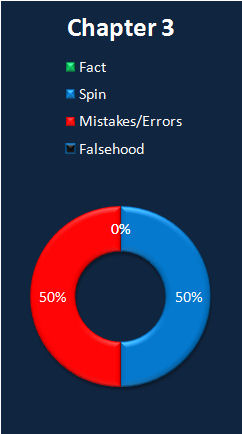
|
Jump to details:
The revelations in the Book of Commandments were modified because they were "showing their age," "contained outdated information," "included erroneous statements" and "abandoned doctrines." Some of the revelations "revealed too much information about LDS beliefs."
Author's sources:
- Karl F. Best, "Changes in the Revelations, 1833-1835," Dialogue: A Journal of Mormon Thought (Spring 1992), vol. 25, no. 1, p. 90.
- H. Michael Marquardt, The Joseph Smith Revelations: Text & Commentary, p. 17.
Mormons view divine truth as "not absolute or fixed; it is changeable, flexible."
Author's sources:
- Richard N. and Joan K. Ostling, Mormon America: The Power and the Promise, (New York:HarperCollins Publishers, 2000), 249. ( Index of claims )
Joseph received a "false revelation" through his seer stone to go to Toronto, Canada to sell the Book of Mormon copyright.
Author's sources:
- David Whitmer, An Address to All Believers in Christ.

David Whitmer claimed that Joseph Smith received a revelation and prophesied that Oliver Cowdery and Hiram Page should go to Canada where they would find a man willing to buy the copyright to the Book of Mormon. When they failed to sell the copyright, Whitmer states that Joseph admitted that the revelation had not come from God.
The primary evidence supporting the negative aspects of the Canadian Mission story comes from David Whitmer, who was not a participant in the event, and who had left the church many years before. With the discovery of the Hiram Page letter of 1848 showing that the actual participants involved in the trip felt that Joseph Smith delivered an accurate revelation of what would transpire on the Mission, and in fact even found the event uplifting rather than negative, it is evident that no individual contemporary to the event felt that this represented a false prophecy by Joseph Smith. What we do see is excellent evidence in fulfillment of the teachings of Deuteronomy 12 and 18 that Joseph Smith was perceived as a true prophet of God by those involved in the Mission to Canada in early 1830.
Joseph modified the revelation now found in D&C 5:4 to add additional gifts. After translating the Book of Mormon he was not supposed to become a prophet or organize a Church.
Author's sources:
- Karl F. Best, "Changes in the Revelations, 1833-1835," Dialogue: A Journal of Mormon Thought (Spring 1992), vol. 25, no.1, p. 98.
Wrote Elder Marlin K. Jensen in 2009:
One of Joseph Smith’s tasks in reviewing the manuscripts prior to their publication was to “correct those errors or mistakes which he may discover by the Holy Spirit.” Joseph knew from experience that the human process of writing down revelations, copying them into manuscript books, and then passing them through various hands in preparation for publication inevitably introduced unintentional errors. Sometimes changes were required to clarify wording. Occasionally, later revelations would supersede or update previously received revelations, necessitating the editing of documents to alter previous versions. Various other changes were also made from time to time. Most of these, such as dividing the text into verses or clarifying meaning, did not involve substantive corrections.
Joseph seemed to regard the manuscript revelations as his best efforts to capture the voice of the Lord condescending to communicate in what Joseph called the “crooked, broken, scattered, and imperfect language” of men." The revealed preface to the published revelations also seems to express this principle: “I am God and have spoken it; these commandments are of me, and were given unto my servants in their weakness, after the manner of their language” (D&C 1꞉24).
Joseph and his associates were appointed by the actions of Church conferences to prepare the revelations for publication by correcting the texts. Recent analysis of both manuscript revelation books reveals how and when many of the changes were made. For example, some changes were made before selected items were published in Missouri, while others were made in Ohio before the 1835 publication of the Doctrine and Covenants.
One common example involves changes made by Sidney Rigdon. He often changed the language in the revelations from the biblical “thee,” “thy,” and “thine” to the modern “you,” “your,” and “yours.” Many of these changes were later reversed. He also corrected grammar and changed some of the language to clarify and modify words and meaning.
In a few cases, more substantive changes were made as revelations were updated for the 1835 Doctrine and Covenants. For example, section 20 was originally received in 1830, before much of the leadership structure of the Church as we know it today was revealed to Joseph Smith. By 1835 Joseph had organized many offices and quorums by revelation. To include this newly revealed ecclesiastical order, several text changes and additions were incorporated into section 20. Our current verses 65–67 on ordaining men to priesthood offices, for instance, had been revealed after the 1833 publication and were subsequently added to the 1835 publication.
Joseph Smith reviewed many of his associates’ editorial changes and made slight alterations in his own hand before A Book of Commandments was published in 1833. He made additional changes, including adding surnames to individuals mentioned in the revelations, just before the Doctrine and Covenants was published in 1835.
Sometime around 1834–35 in Kirtland, Ohio, Revelation Book 2 was used for the preparation of the 1835 Doctrine and Covenants, and all but eight items in the manuscript book were published in that 1835 volume. In contrast, just three of the revelations copied into the book were published in A Book of Commandments in 1833. Two of the manuscript book’s revelations were first published in the 1844 Doctrine and Covenants.
Subsequent editing changes through the 1981 edition of the Doctrine and Covenants involved occasional word changes, but the major substantive changes occurred under the Prophet Joseph’s guidance for the 1835 edition.[1]
Joseph modified what is now D&C 8:6-9 to hide Oliver Cowdery's use of a divining rod.
Author's sources:
- D. Michael Quinn, Early Mormonism and the Magic World View, revised and enlarged edition, (Salt Lake City: Signature Books, 1998), 206 ( Index of claims )
- H. Michael Marquardt, The Joseph Smith Revelations: Text & Commentary, pp. 14-15.
Revelations in Context on history.lds.org:
Oliver Cowdery lived in a culture steeped in biblical ideas, language and practices. The revelation’s reference to Moses likely resonated with him. The Old Testament account of Moses and his brother Aaron recounted several instances of using rods to manifest God’s will (see Ex. 7:9-12; Num. 17:8). Many Christians in Joseph Smith and Oliver Cowdery's day similarly believed in divining rods as an instrument for revelation. Cowdery was among those who believed in and used a divining rod.[2]
A revelation received by Joseph praised Oliver Cowdery's gift of using divining talents. The revelation was published in the Book of Commandments in its original form, then subsequently modified in the Doctrine and Covenants. We do not know why Sidney Rigdon chose to alter the wording of the revelation, but he is the one that actually changed the wording to "rod of nature."
We know based upon the text of the revelation that Oliver possessed a gift of working with something alternately referred to as a "sprout," "thing of nature," or "rod of nature." We also know that the Lord approved of Oliver's use of this gift. The reference was later changed to the "gift of Aaron," but we can only speculate as to the exact reason why. According to the Church History website, the "rod" referred to by Sidney Rigdon when he edited the revelation was likely a divining rod. It is possible that "gift of Aaron" was substituted as the revelatory device because if carried fewer negative connotations than "divining rod." However, a "cover up" is not usually done by committee, and it is clear that multiple individuals assisted in editing the revelations before they were to be published in the Doctrine and Covenants. It is also difficult to claim a "cover up" since "rod of nature" was to be published in the Book of Commandments in 1833, only two years before change to "gift of Aaron" was published in the 1835 Doctrine and Covenants.
We do know that Oliver's gift had to do with receiving revelation, and that Oliver attempted to employ it during the period in which the Book of Mormon was being translated. We also know that Oliver's experience in attempting to translate produced one of the lasting lessons which continues to be taught in Church even today—the knowledge that one must study things out in their mind in order to know the truth of something.
The original wording of the revelation along with revisions performed by Oliver Cowdery, William W. Phelps, Sidney Rigdon, Joseph Smith, John Whitmer, and another unidentified editor is recorded in the REVELATION BOOK 1 (April 1829-B [D&C 8]). The original revelation reads as follows:
...remember this is thy gift now this is not all for thou hast another gift which is the gift of working with the sprout Behold it hath told you things Behold there is no other power save God that can cause this thing of Nature to work in your hands. [3]
Sidney Rigdon edited the passage to read like this:
...remember this is your gift now this is not all for you have another gift which is the gift of working with the rod Behold it has told you things Behold there is no other power save God that can cause this rod to work in your hands. (emphasis added)
In the Book of Commandments (the predecessor to the Doctrine and Covenants), the revelation underwent an additional revision by a publication committee of the First Presidency (Joseph Smith, Oliver Cowdery, and Frederick G. Williams). The Book of Commandments stated:
Chapter 7:3—Now this is not all, for you have another gift, which is the gift of working with the rod: behold it has told you things: behold there is no other power save God, that can cause this rod of nature, to work in your hands, for it is the work of God. (emphasis added)
In the 1835 Doctrine and Covenants, this was revised to read:
D&C 8:6–8—Now this is not all thy gift; for you have another gift, which is the gift of Aaron; behold, it has told you many things; Behold, there is no other power, save the power of God, that can cause this gift of Aaron to be with you. Therefore, doubt not, for it is the gift of God; and you shall hold it in your hands, and do marvelous works; and no power shall be able to take it away out of your hands, for it is the work of God. (1921 edition, 8:6–8.) (emphasis added)
Thus, "working with the sprout" and the "thing of Nature" were changed to "the gift of working with the rod," which was again later revised to "the gift of Aaron." It has been assumed on the basis of this that Oliver Cowdery was a "rodsman," or someone who used a divining rod to search for treasure, water, or other things hidden.
Evidence used to support this assertion is the fact that in 1801, a religious sect led by the Wood family enjoyed a brief popularity, and they sought for treasure with divining rods. [4] The Wood group was reportedly taught this skill by a counterfeiter/forger named either Winchell or Wingate. Winchell/Wingate had been a guest at the home of Oliver's father, William. Attempts have been made to tie William Cowdery to the Wood group, but there is no evidence that he had any connection with them aside from knowing Winchell/Wingate. As Richard L. Anderson observed:
An 1828 newspaper history of the Wood episode refers to neither the mysterious counterfeiter nor Cowdery. The main group of Middletown survivors of the 1800 period--"more than thirty men and women"--were interviewed up to 1860, and they said nothing of a counterfeiter or of Cowdery. The 1867 recollections of a minister who visited the group in the final weeks of their movement include mention of the counterfeiter but not Cowdery--when a disciple was asked where the criminal stayed, he answered: "He keeps himself secreted in the woods." Frisbie's own claims about the Cowdery connection to the Wood group are both unclear and unsupported. This is the patchwork of folklore, not tightly woven history. [5]
It is therefore not clear whether Oliver used a rod for treasure seeking. The critical association of Oliver's possible use of a rod with the activities of local "rodsmen" seeking treasure is used to imply that Oliver was also a treasure seeker.
Apostle William E. McLellin left the Church because he was "shaken by the changes made in the revelations."
Author's sources:
- "The Early History of the Saints and Their Enemies," Sept. 28, 1875, Salt Lake Daily Tribune, Dec. 5, 1878
- William McLellin, Saint's Herald, vol. 17, pp. 556-557.
he said he had no confidence in the presidency of the Church; consequently, he had quit praying and keeping the commandments of the Lord, and indulged himself in his sinful lusts. It was from what he had heard that he believed the presidency had got out of the way, and not from anything that he had seen himself.[6]
McLellin had previously been excommunicated for spending time with "a certain harlot" while on a mission.[7] He had also been out of fellowship for "writing a letter which "cast…censure upon the [first] presidency."[6]
Joseph Smith turned the "Book of Breathings" into the "Book of Abraham." Joseph claimed that the "Book of the Dead" had been written by Joseph of Egypt.
Author's sources:
- No source provided.
"Translation and Historicity of the Book of Abraham," Gospel Topics on LDS.org:
The discovery of the papyrus fragments renewed debate about Joseph Smith’s translation. The fragments included one vignette, or illustration, that appears in the book of Abraham as facsimile 1. Long before the fragments were published by the Church, some Egyptologists had said that Joseph Smith’s explanations of the various elements of these facsimiles did not match their own interpretations of these drawings. Joseph Smith had published the facsimiles as freestanding drawings, cut off from the hieroglyphs or hieratic characters that originally surrounded the vignettes. The discovery of the fragments meant that readers could now see the hieroglyphs and characters immediately surrounding the vignette that became facsimile 1.
None of the characters on the papyrus fragments mentioned Abraham’s name or any of the events recorded in the book of Abraham. Mormon and non-Mormon Egyptologists agree that the characters on the fragments do not match the translation given in the book of Abraham, though there is not unanimity, even among non-Mormon scholars, about the proper interpretation of the vignettes on these fragments.[8]—(Click here to continue)

Believing that one of the papyrus rolls contained, "the writings of Abraham while he was in Egypt," and "purportedly written by his own hand, upon papyrus,"[9] Joseph commenced a translation. The Book of Abraham was the result of his work.
The translated text and facsimiles of three drawings were published in the early 1840s in serial fashion in the LDS newspaper Times and Seasons. The entire work was published in 1852 in England as part of The Pearl of Great Price, which was later canonized as part of LDS scripture.
Joseph Smith had in his possession three or four long scrolls, plus a hypocephalus (Facsimile 2). Of these original materials, only a handful of fragments were recovered at the Metropolitan Museum. The majority of the papyri remains lost, and has likely been destroyed. Critics who claim that we have all, or a majority, of the papyri possessed by Joseph Smith are simply mistaken.
The Egyptian characters on the recovered documents are a portion of the "Book of Breathings," an Egyptian religious text buried with mummies that instructed the dead on how to successfully reach the afterlife. This particular Book of Breathings was written for a deceased man named Hor, so it it usually called the Hor Book of Breathings.
Other than the vignette represented in Facsimile 1, the material on the papyri received by the Church, at least from a standard Egyptological point of view, does not include the actual text of the Book of Abraham. This was discussed in the Church publication, the New Era in January 1968.
After Joseph's death, the collection was eventually sold and split up. The original papyri were thought to have been completely destroyed in the Chicago fire of 1871. Fragments, however, including the illustration represented in Facsimile 1, were discovered in 1966 in the Metropolitan Museum of Art in New York City, who gave them to The Church of Jesus Christ of Latter-day Saints in November 1967.
There are eleven fragments of the original papyrus owned by Joseph Smith. The initial labels given the fragments came from Hugh Nibley's work.
The fragments that exist and their source are described in the table below, as are other materials of interest to students of the Book of Abraham:
| Fragments | Source | Comments |
|---|---|---|
|
|
|
|
|
|
|
|
|
|
|
|
|
|
|
The restoration of the missing portions of Facsimile 1 were "terribly wrong."
Author's sources:
- Charles M. Larson, By His Own Hand Upon Papyrus: A New Look at the Joseph Smith Papyri, 2nd ed., (Grand Rapids, MI: Institute for Religious Research, 1992), .
The Larson restoration presumes that the upper hand represented in Facsimile 1 is instead the wing of a bird. There are several elements which disprove this.
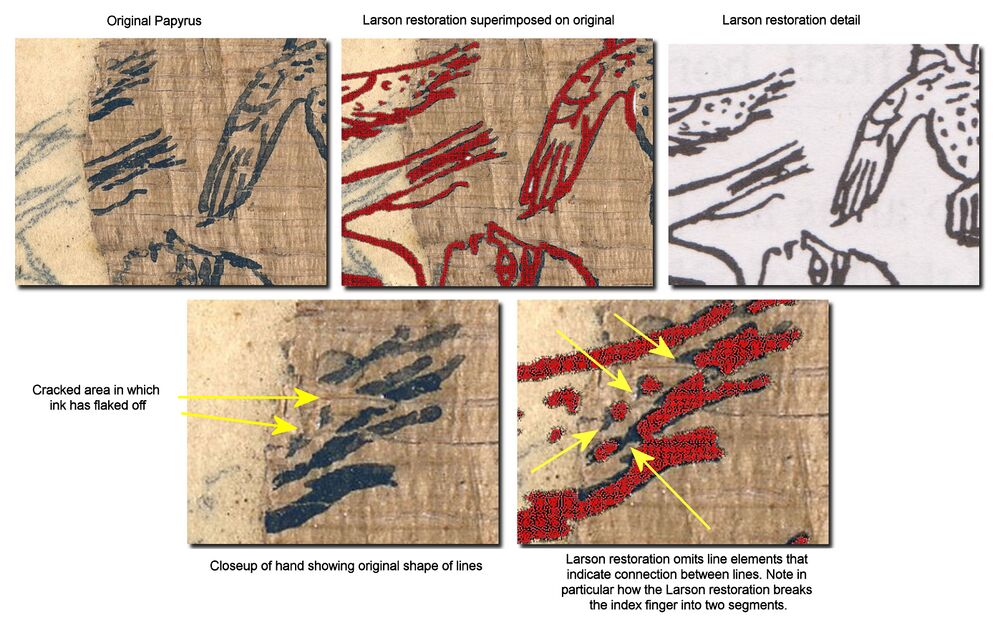
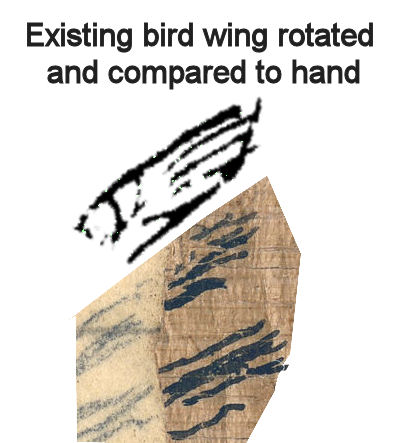
(non-Mormon) Egyptologist Lanny Bell
Let me state clearly at the outset my conviction that the questionable traces above the head of the Osiris figure are actually the remains of his right hand; in other words, Joseph Smith was correct in his understanding of the drawing at this point. Ashment 1979, pp. 36, 41 (Illustration 13), is very balanced in his analysis of the problem, presenting compelling arguments for reading two hands; Gee 1992, p. 102 and n. 25, refers to Michael Lyon in describing the "thumb stroke" of the upper (right) hand; cf. Gee 2000, pp. 37-38; and Rhodes 2002, p. 19, concludes: "... a careful comparison of the traces with the hand below as well as the tip of the bird's wing to the right makes it quite clear that it is the other hand of the deceased."...An important clue is provided in the orientation of the thumbs of the upraised hands toward the face. This is the expected way of depicting the hands of mourners and others when they are held up to (both sides of) their heads or before their faces.[10]
The Larson restoration adds a phallus on the reclining figure, something that is never seen on a clothed Osiris figure.
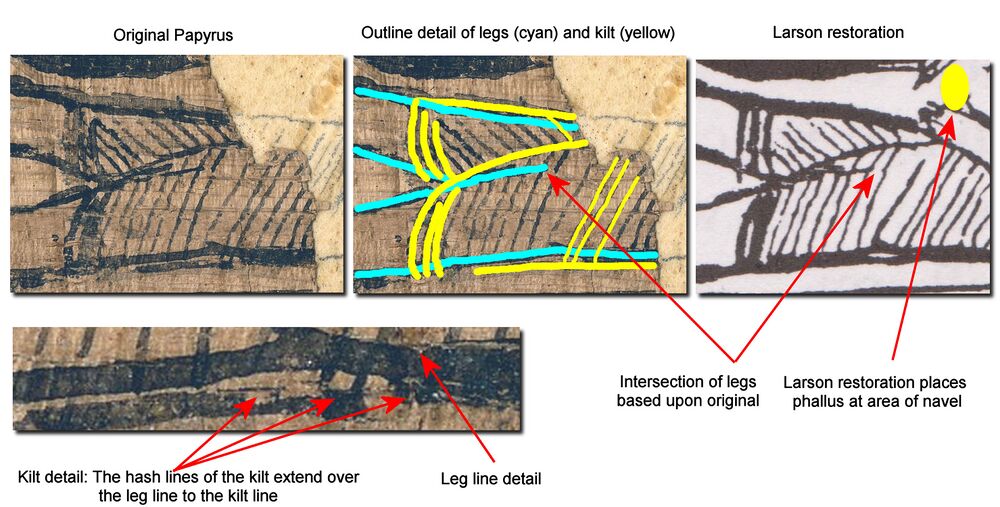
(non Mormon) Egyptologist Lanny Bell:
[T]he representation of an ithyphallic figure wearing a kilt would not be unparalleled. However, judging from the position of the erect phallus of the reclining kilted earth god Geb in a cosmological scene on Dynasty 21 Theban coffins now in Turin and Bristol, there would not be enough available space to restore the hand of Anubis, the erect phallus of the Osiris, and the body and wings of Isis in P.JS I: Anubis would have to be grasping the phallus himself and assisting Isis in alighting on it—which is unimaginable. . . .In this area, I believe the Parker-Baer-Ashment reconstruction (with its "implied" erect phallus) is seriously flawed.[11]
The head of the priest in the Hedlock restoration appears to simply copy the head of the reclining figure. An examination of the papyrus, however, shows evidence that the head was originally that of Anubis. In this case, the Larson restoration appears to be correct. Theologically, it would not matter to scenes such as this one. Ancient art depcting religious situations such as this frequently had other people impersonating other Gods. Thus, even if this is an incorrect restoration, it would not matter to the overall message of the scene portrayed.
The priest of Elkenah likely could have been wearing an Anubian headdress while performing this scene and the interpretation would still be, for all intents and purposes, correct. Those performing rituals often donned a mask impersonating a particular god for theological effect.[12]
John Gee has written:
The discussion about figure 3 has centered on whether the head should be that of a jackal or a bald man. Whether the head is a jackal or a bald man in no way affects the interpretation of the figure, however, since in either case the figure would be a priest.
His footnote here reads as follows:
The argument for the identification runs as follows:
(1) Assume for the sake of argument that the head on Facsimile 1 Figure 3 is correct. What are the implications of the figure being a bald man? Shaving was a common feature of initiation into the priesthood from the Old Kingdom through the Roman period. Since “Complete shaving of the head was another mark of the male Isiac votary and priest” the bald figure would then be a priest.
(2) Assume on the other hand that the head on Facsimile 1 Figure 3 is that of a jackal, as was first suggested by Theodule Devéria. We have representations of priests wearing masks, one example of an actual mask, [and] literary accounts from non-Egyptians about Egyptian priests wearing masks. . . . Thus, however the restoration is made, the individual shown in Facsimile 1 Figure 3 is a priest, and the entire question of which head should be on the figure is moot so far as identifying the figure is concerned. (John Gee, “Abracadabra, Isaac, and Jacob,” Review of Books on the Book of Mormon 7/1 [1995]: 80–82)[13]
Gee gives an example of this of a bald priest donning the head of Anubis at the temple of Dendara. The first image is an actual drawing created during the Ptolemaic period from Dendara of the priest putting on the mask. The second is an example of such a mask that would be placed on them.


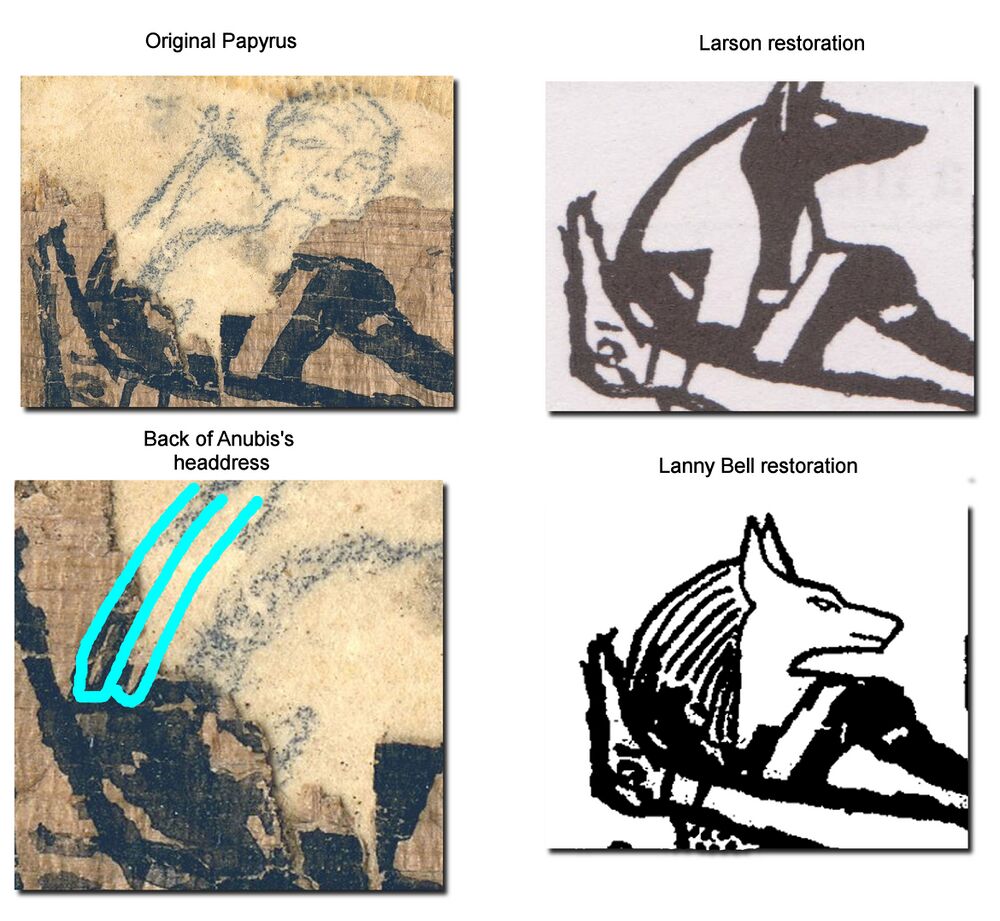
LDS apologists' main purpose is to explain away "any and all criticisms that might damage the validity of Smith's writings."
Author's sources:
- Author's opinion.
Documents show how the hieroglyphs from the papyri were matched to the Book of Abraham text. One or two words in Egyptian were expanded to entire paragraphs in English.
Author's sources:
- Richard L. Bushman, "Joseph Smith as Translator, in Waterman, p. 81.
Once the Book of Abraham translation was complete, a unique opportunity existed to use the completed translation in an attempt to match it against the Egyptian characters on the papyri and produce a correlation between English and Egyptian. The Church addresses this possibility on LDS.org:
Some evidence suggests that Joseph studied the characters on the Egyptian papyri and attempted to learn the Egyptian language. His history reports that, in July 1835, he was “continually engaged in translating an alphabet to the Book of Abraham, and arrangeing a grammar of the Egyptian language as practiced by the ancients.” This “grammar,” as it was called, consisted of columns of hieroglyphic characters followed by English translations recorded in a large notebook by Joseph’s scribe, William W. Phelps. Another manuscript, written by Joseph Smith and Oliver Cowdery, has Egyptian characters followed by explanations.[14]
The reverse engineering hypothesis gains traction once we see that the translation of the Book of Abraham (as some have supposed are demonstrated by the characters in the margins of the translation manuscripts) and the characters in the GAEL:
Yet some have supposed that the Egyptian Alphabet was the tool used to create the translation. In order to assess whether this could be the case or not, I conducted research to test the assumption. First, I located all of the phrases in the Egyptian Alphabet that also appear in the Book of Abraham. I then compared the Egyptian characters next to those phrases to the Egyptian characters adjacent to the matching lines in the early Book of Abraham manuscripts. Of the twenty-one times I found text in the Egyptian Alphabet that matched text in the Book of Abraham, I found only one time that the corresponding Egyptian characters matched, four times when part of the characters matched, and sixteen times in which there was no match whatsoever. Clearly the Egyptian alphabet was not used to translate the papyri, nor is there any demonstrable relationship between the characters on the papyri and the text of the Book of Abraham. This is not surprising since the characters come from fragments of papyri that eyewitnesses noted were not the source of the Book of Abraham.[15]
Even further evidence of this is the presence of Hebrew in the GAEL. This is further explicated by Jeff Lindsay[16]

FAIR is a non-profit organization dedicated to providing well-documented answers to criticisms of the doctrine, practice, and history of The Church of Jesus Christ of Latter-day Saints.
We are a volunteer organization. We invite you to give back.
Donate Now